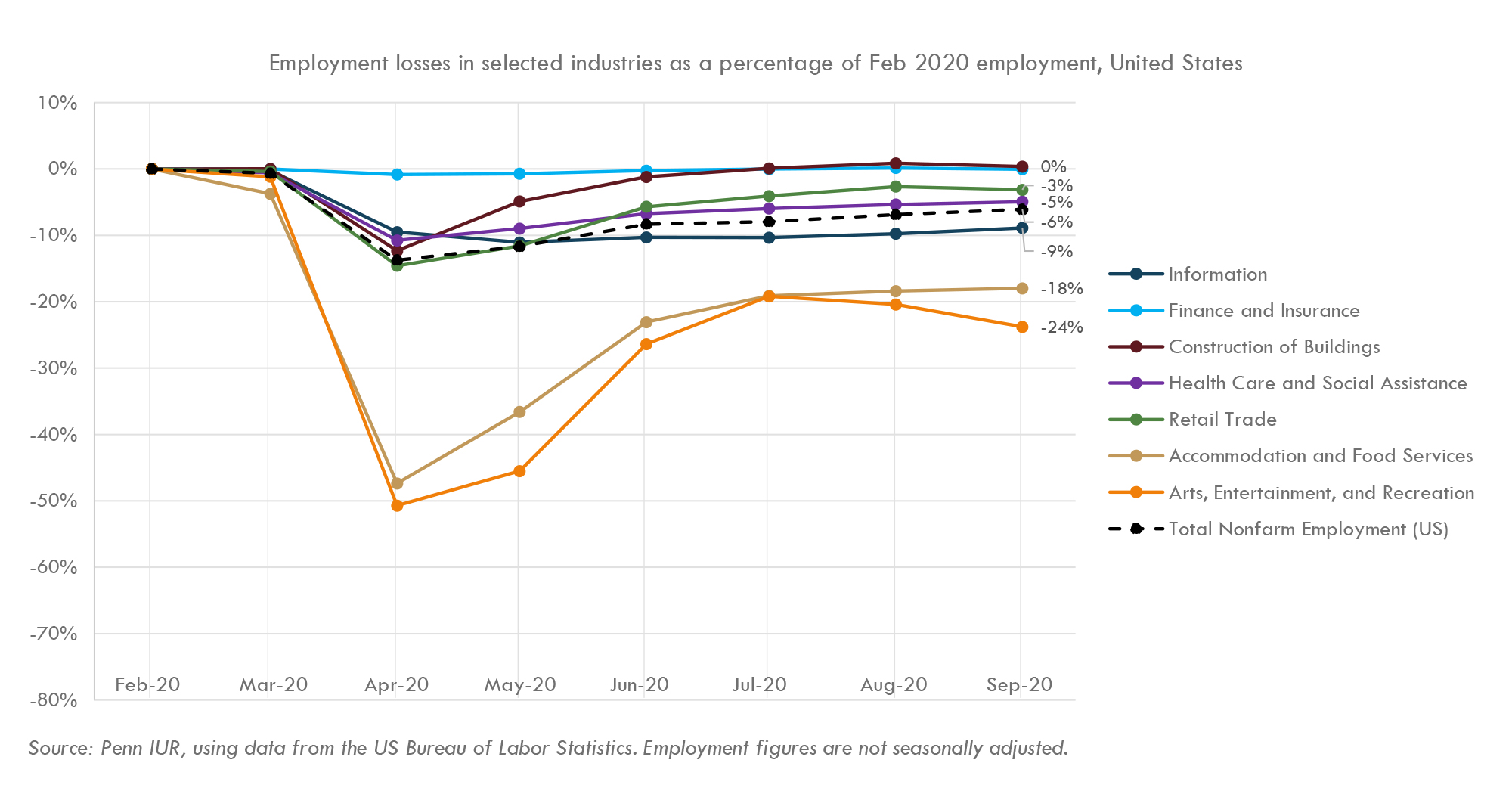
The chart above shows losses in employment in selected industries in New York City between February 2020, just before the effects of the coronavirus pandemic were first felt in the city, and September 2020. As the black dashed line shows, overall employment in New York City declined by 14 percent between February and September; it has been gradually recovering since April, when employment reached a low of 20 percent below February levels.
However, these figures mask considerable variation between industries. For example, the chart shows that employment in New York City’s Finance and Insurance industry has not dropped more than 4 percent throughout the pandemic. Employment in the Information industry also barely dropped, and is now nearly back to pre-pandemic levels. (Definitions of all industry categories are available at the U.S. Bureau of Labor Statistics website.)
Contrast these figures with the Accommodation and Food Services industry and the Arts, Entertainment and Recreation industry, which have fared much worse. Both these industries lost between 60 and 70 percent of their jobs by April. While employment in the Accommodation and Food Services industry has been slowly recovering since that nadir, jobs in the Arts, Entertainment and Recreation industry have still not started to return to the city. Meanwhile, employment in building construction fell by 40 percent between February and April but had almost fully recovered by September. Jobs in the Retail industry and the Health Care and Social Assistance industry did not drop as far but have also not rebounded as quickly. The fate of employment in Health Care and Social Assistance is particularly important to track, as the industry provides 18 percent of jobs in the city, or more than one out of every six. This is more than double the share of New York City jobs in the other industries mentioned above (Finance and Insurance: 7 percent; Information: 4 percent; Accommodation and Food Services: 8 percent; Arts, Entertainment and Recreation: 2 percent; Retail: 7 percent, as of February 2020.)

As the second graph shows, employment across the United States has not declined as much as in New York City. By September, U.S. employment was only 6 percent lower than it had been before the pandemic. However, nationally too, industries related to activities that usually require members of the public to congregate, like Accommodation and Food Services or Arts, Entertainment and Recreation, have suffered the greatest job losses and been slow to recover.
As of September 2020, total non-farm employment in New York City remains 14 percent lower than February 2020 levels—nearly triple the national employment losses. This is primarily driven by losses in the accommodation and food services sector (-42 percent) and the arts, entertainment and recreation sector (-64 percent), which are both nearly triple the national rates of job loss. As of February 2020, the shares of national employment in the industries mentioned above are: Accommodation and Food Services: 9 percent; Arts, Entertainment and Recreation: 1 percent; Retail: 10 percent; Health Care and Social Assistance: 14 percent, Finance and Insurance: 4 percent; Information: 2 percent.
Employment figures such as these are among a suite of indicators that Penn IUR is monitoring as part of its Recovering Cities Project, of which New York is the pilot city. Every two months, the Penn IUR team presents these indicators in the form of a dashboard to a panel of civic leaders and experts specially convened to help monitor the city’s recovery from the pandemic. The insights and perspectives of this group help understand and interpret data such as those presented in this figure, and what their implications are for residents, businesses, and policymakers.

